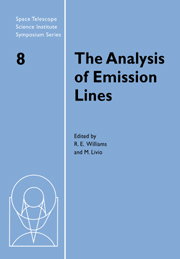Book contents
- Frontmatter
- Contents
- Participants
- Preface
- Emission Lines: Past and Future
- Atomic Data for the Analysis of Emission Lines
- Radiative Transfer
- Emission Lines from Winds
- Photoionizing Shocks
- The Lexington Benchmarks for Numerical Simulations of Nebulae
- Emission Line Diagnostics
- Ultraviolet Spectroscopy
- Infrared Emission Lines as Probes of Gaseous Nebulae
- Molecular Emission Line Diagnostics in Astrophysical Environments
- Abundance Determinations
- Astrophysical Gamma Ray Emission Lines
- Summary Remarks
Radiative Transfer
Published online by Cambridge University Press: 23 November 2009
- Frontmatter
- Contents
- Participants
- Preface
- Emission Lines: Past and Future
- Atomic Data for the Analysis of Emission Lines
- Radiative Transfer
- Emission Lines from Winds
- Photoionizing Shocks
- The Lexington Benchmarks for Numerical Simulations of Nebulae
- Emission Line Diagnostics
- Ultraviolet Spectroscopy
- Infrared Emission Lines as Probes of Gaseous Nebulae
- Molecular Emission Line Diagnostics in Astrophysical Environments
- Abundance Determinations
- Astrophysical Gamma Ray Emission Lines
- Summary Remarks
Summary
This brief overview for the non-specialist presents certain aspects of radiative transfer theory important for the quantitative interpretation of astrophysical spectra.
Introduction
The theory of radiative transfer has made spectacular advances in the past decade, both in the understanding of fundamentals and in computational techniques. However, apart from the solar/stellar community, these important tools for the interpretation of astrophysical spectra are neither recognized nor effectively used. It is hoped that this brief overview will be useful in communicating the state of understanding and guiding potential users to the appropriate literature. This paper is not intended as a review, but as a discussion of two important developments related to Osterbrock (1962).
The role of radiative transfer theory in the quantitative interpretation of spectra seems not to be widely understood. The crucial importance of radiative transfer processes as the link between an astronomical object and the determination of its physical properties is discussed in Sect. 2.
Although the necessity of treating radiation scattered in spectral lines as non-coherent, i.e., experiencing slight shifts in frequency in each scattering, is well understood, the conditions under which one can employ the simplifying assumption of complete redistribution are less well known. This issue is discussed in Sect. 3, starting from the discussion in Osterbrock (1962). Sect. 4 contains a detailed comparison of numerical solutions of the transfer equation with various assumptions concerning treatment of redistribution.
The solution of the combined radiative transfer and statistical equilibrium equations for atomic models with a large number of levels, and in various geometrical configurations, lies at the heart of the quantitative astrophysical spectroscopy.
- Type
- Chapter
- Information
- The Analysis of Emission Lines , pp. 35 - 48Publisher: Cambridge University PressPrint publication year: 1995



